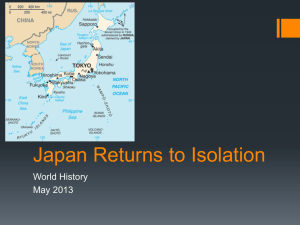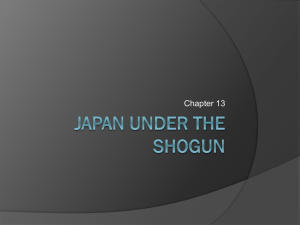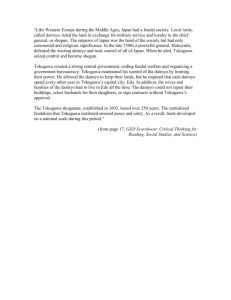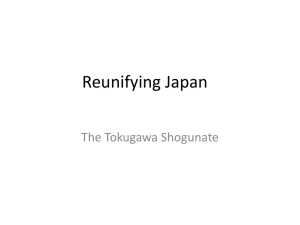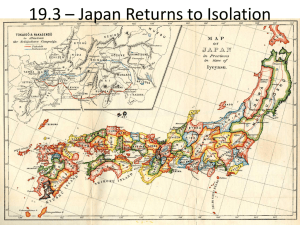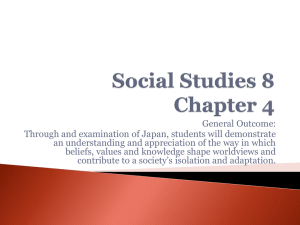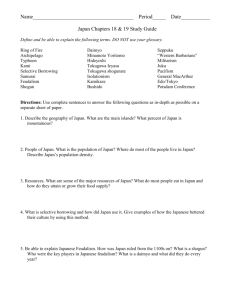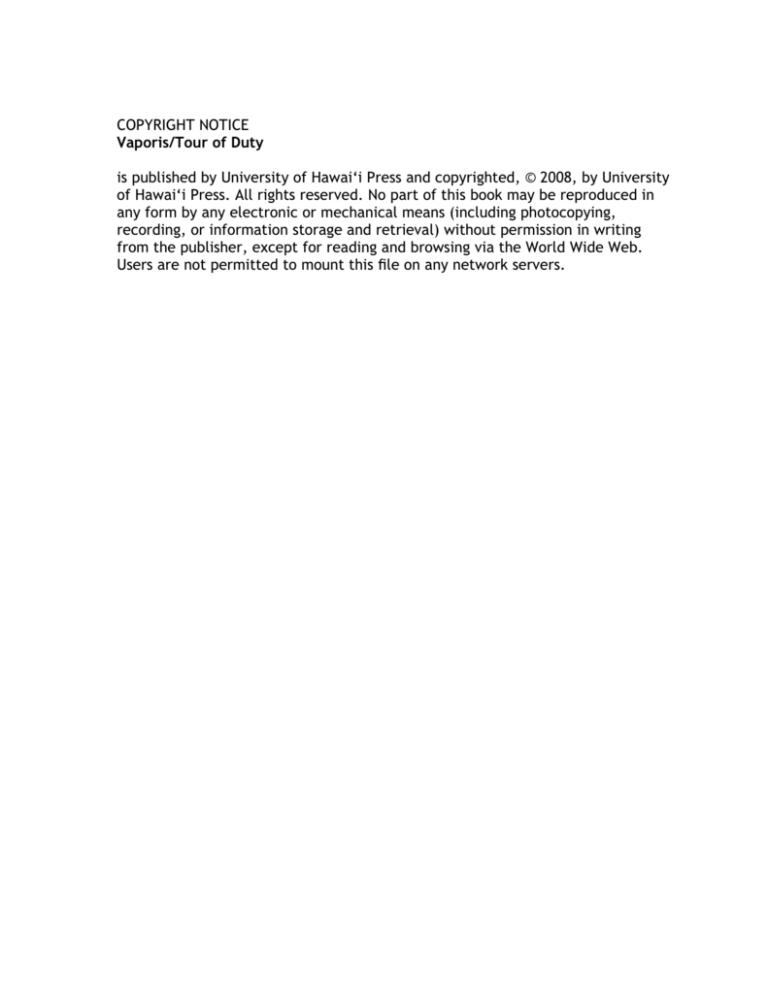
COPYRIGHT NOTICE
Vaporis/Tour of Duty
is published by University of Hawai‘i Press and copyrighted, © 2008, by University
of Hawai‘i Press. All rights reserved. No part of this book may be reproduced in
any form by any electronic or mechanical means (including photocopying,
recording, or information storage and retrieval) without permission in writing
from the publisher, except for reading and browsing via the World Wide Web.
Users are not permitted to mount this file on any network servers.
Introduction
Every year for more than two and a half centuries, samurai in service
to their daimyo marched early modern Japan’s highways back and forth from
their domain’s castle town to Edo, the political capital of the realm and the
center from which the Tokugawa family governed its domain. Theirs was no
recreational trip. It was a forced movement, known as alternate attendance, or
sankin kōtai, imposed by legal fiat: The shogun required the daimyo to leave
their domains to come wait on him, usually for a year at a time. The daimyo,
furthermore, were required to keep their wives and most of their adolescent
children in permanent residence in Edo, where they served, in effect, as hostages, acting as guarantees for the daimyo’s continued good behavior. The practice was so emblematic of the Tokugawa or early modern period, and Japanese
culture in general, that when the Englishman Algernan Mitford visited Japan
in 1906 to deliver the Order of the Garter from King Edward VII to the Meiji
emperor, a representation of a daimyo’s procession was recreated as entertainment for distinguished foreign and Japanese guests.1 The proceedings, which
took place in Hibiya Park, resonated with Lord Mitford, who had experienced
Tokugawa Japan in 1866–1867, during its last years. Alternate attendance, more
than anything else, evoked the Tokugawa past to him:
Feudalism is dead, but its ghost haunts me still. I shut my eyes and see
picturesque visions of warriors in armour. . . . Processions of powerful
nobles with their retinues marching along the cryptomeria avenues of the
Tōkaidō, the road by the eastern sea — and I hear the cry “Shita ni iro,
Shita ni iro” [Get down, get down], at which all men of low degree go down
upon their knees and bow their heads in the dust while the great man
[the daimyo] passes, silent and gloomy in the loneliness of the norimono
[palanquin].”2
These processions remain symbolic of the Tokugawa era even today, as cities
and towns through which the daimyo passed regularly stage re-enactments to
draw tourists.
While alternate attendance was devised in part as a control measure and
this intent is usually emphasized in the secondary literature,3 it needs to be
2
tou r of du t y
seen within the context of the development of political institutions in Japanese
history. It entailed the elaboration and codification of the centuries-old practice
of the lord requiring the periodic attendance of his retainers by his side. It was
a form of feudal service, or hōkō, one of a set of military-type service owed the
Tokugawa by their vassals, the daimyo, in return for the bestowal of land grants
and the right to rule those entities. The system as elaborated by the Tokugawa,
however, called for the regular attendance of the more than 250 lords for almost
the entire duration of shogunal rule, and it effectively consolidated power in a
single place, the city of Edo.
Alternate attendance was a bedrock of the Tokugawa polity. Despite the
weakening of Tokugawa power that scholars have noted in other areas,4 it was
one of the most durable of the shogun’s political controls over the daimyo. In institutional terms it underwent little change. Repeatedly issued in the “Laws for
the Military Houses” (Buke shohatto), the attendance requirements were altered
only once from their formal inception in 1635 until 1862. In this regard alternate
attendance stands perhaps as the single exception to the general relaxation of
control measures by the shogunate over the course of the Tokugawa period.
While alternate attendance might remind us of other practices observed in
European countries, such as Louis XIV’s court at Versailles in the late seventeenth and early eighteenth centuries or the medieval German practice of hoffahrt, or “going to court,” the comparisons are not particularly apt, for in the
Japanese case the requirements had far greater historical significance.5 Alternate
attendance not only helped deplete the war-making capabilities of the daimyo,
but it also acted as an agent of far-reaching change, generating extensive economic growth, urbanization, and social transformations. With foreign trade
largely restricted by political fiat, alternate attendance functioned as a powerful
internal economic stimulant. The considerable expenses involved in participation in the system — including transport and travel services, the construction
and repair of a network of compounds in Edo, and the maintenance of support
staffs there — spread those expenditures along the highways, the development
of which the daimyo promoted, as well as in Edo and the domains. Expenses
related to alternate attendance could consume as much as 50 to 75 percent of a
domain’s cash income and greatly restricted the daimyo’s rule. It was without
question the most important institution affecting economic life in Tokugawa
Japan.
The system’s impact on the development of the city of Edo was tremendous,
as evidenced by rapid population growth, reaching a figure in excess of one
million by the early eighteenth century, and the concomitant rise in consumer
needs. It also resulted in waves of growth in cities below Edo in the urban hierarchy, as daimyo developed their castle towns and mobilized local resources to
meet the costs of alternate attendance. This trickle-down effect impacted urban
Introduction
centers and castle towns as well as local commercial settlements. Osaka in particular was transformed, as daimyo sold tax rice or other goods there to obtain
the necessary cash for alternate-attendance-related expenses. This prompted
the development of Osaka as a market and finance center and, more generally,
stimulated the development of a commercial or money economy and a system
of credit. As a result, Osaka’s dominant position in the economy was established by the end of the seventeenth century. Its merchants assumed national
importance as the mechanism of credit between Osaka and Edo left large sums
of interest-free tax money in their hands, funds they used as lending capital.6
To cope with the spiraling cost of alternate attendance, domains were forced
to adopt a variety of strategies to meet expenses. They rationalized bureaucratic administration and reduced the size of processions. They also increased
income through domain monopolies and export-oriented trade policies, which
led at least in part to further commercialization of the economy. But, from the
early eighteenth century, it was the samurai who bore the brunt of the daimyo’s
efforts to economize through the repeated implementation of kariage, or forced
borrowings.
The periodic absence of the lord and a group of his top retainers on alternate
attendance also influenced the form and nature of early modern governance.
More specifically, it led to a bifurcation of domainal government, with divisions
in both Edo and the castle town, each handling a different range of affairs. The
Edo branch, for example, largely managed interdomainal relations, while the
castle town branch handled the daily affairs of domainal governance. This bifurcation occasionally caused conflict between the two, in some cases leading
to the confiscation (attainder) of a domain. The regular absence of the lord created a power vacuum into which his top senior retainers stepped, making many
lords largely figurehead rulers. This accelerated the bureaucratization of local
power, a predictable outcome of the two hundred years of the pax Tokugawa or
Great Peace ([tenka] taihei).
Alternate attendance also functioned, in effect, as a mechanism of intercity
mobility for the elite, accounting for as many as one-third of Edo’s population.
In terms of the volume of circulation and degree of geographic mobility created
within a country’s borders, alternate attendance is probably without parallel in
world history. Despite this historical significance, the system in general and this
function of it in particular have been left unexplored. A system of elite mobility
existed in contemporaneous China, where officials were recruited largely based
on the examination system and were sent across the country to serve in metropolitan and county seats and in the capital. This system caused elite mobility,
but of a more specialized type than in Tokugawa Japan, and far fewer people
were involved.7
In restraining the development of domainal military capabilities by the di-
3
4
tou r of du t y
version of wealth, alternate attendance did much to bring peace to the land.
After more than a century of almost constant warfare, the daimyo were forced
to focus their energies on meeting the requirements of periodic attendance
with the shogun and dealing with its consequences. One unintended effect of
the congregation of the daimyo and their representatives in Edo was that, on
their own initiative, daimyo formed cooperative networks of specially designated diplomatic officials who met to discuss political and economic problems,
including how to handle relations with the Tokugawa government. Through
the organic development of this new institution, domainal governments were
able to resolve disputes independently before they became the concern of the
hegemon (the shogun) in Edo, as well as coordinate policy vis-à-vis the shogunate, thus promoting peaceful coexistence and the continued survival of the
domains.
This is but a partial and cursory accounting of some of the implications and
effects of alternate attendance. In short, it is generally agreed that alternate attendance was the single greatest accomplishment of Japanese leaders, both of
the Tokugawa period and of subsequent times. Its significance seems so obvious perhaps that scholars have been content to reiterate generalities without
actually examining the system nor exploring in depth its varied implications.8
There are studies of the physical infrastructure of the network of compounds
and the use of space therein, investigations of the life of domainal retainers
serving in Edo, and explorations of the material culture excavated from the
ruins of Edo’s daimyo compounds and other parts of the city.9 My own research
here and elsewhere has engaged with this literature and, as the endnotes will
make clear, has greatly benefited from it.
Alternate attendance affected Tokugawa Japan on so many different levels that
to write a study of its effects on political, economic, and cultural developments
would require, as George Tsukahira noted, “nothing less than a complete social
history of Tokugawa Japan.”10 This is perhaps why Nishiyama Matsunosuke, one
of Japan’s foremost cultural historians, has written that “alternate attendance
was of great significance, but there has been no full-scale study of it.”11
An important reason why there has been so little study of alternate attendance, despite its centrality to Tokugawa Japan, is that the documentary basis
for it is so scattered. There is not a full range of sources for any single domain.
For example, an extensive collection of official documentation, together with
Edo compound maps, procession scrolls, and archaeological evidence, but very
few retainer diaries, exist for Kaga domain. Such retainer diaries — a key source
for this study — exist in considerable numbers for Tosa domain. Official documentation for Tosa is also voluminous, but maps and procession scrolls are
few and archaeological evidence scant. The unevenness in the documentary
evidence is manifold. Suffice it to say that given this difficulty, the present study
Introduction
is based on a consolidation of evidence from a number of domains. While Tosa
is the main thread that runs through it, supplemental materials are provided
from numerous other localities to provide a fuller picture of the system and its
impact on early modern Japan.
The principal concern of my research has been, and continues to be, how
political institutions impact the human condition. That is to say, while I will
not ignore the issue of how alternate attendance influenced Japan on the level of
the domain, my main concern is to examine the institution in terms of the individual. Of course, in one sense the domain was nothing more than a collective
of individuals. However, my purpose here is to put a human face on the political institution — to render alternate attendance as a lived experience. As much
as extant documentation allows, I examine what the trip to and from Edo was
like, what the period of enforced residence in the nation’s largest city meant to
individual retainers, and how that experience affected both their personal lives
and careers as well as the cultural life of the city of Edo. For members of the
bushi status group and their attendants, participation in alternate attendance
was akin to pilgrimage for commoners. Both helped break barriers, both political and cultural, and expand the intellectual focus of individuals beyond the
domain. The participation of retainers and their subordinates in alternate attendance also had a great impact on their development as consumers. However,
samurai were not only consumers but also producers of culture, the latter being
a role not normally emphasized. Both of these roles will be explored in several
of the chapters. This study also seeks to examine, within defined limits, the
social and economic impact of alternate attendance on the city of Edo, as well
as its role in shaping a national culture.12 The history of alternate attendance as
a mechanism of political control has been ably sketched by Tsukahira, however,
and will not be a focus of inquiry here.
In trying to achieve these various objectives, a principal source for this study
will be the diaries brushed by retainers en route to and from Edo as well as those
they kept while residing in the city. Together with a variety of other sources
— city maps, daimyo compound (daimyō yashiki) maps, and official domainal
records — the diaries provide the means to begin to write a social history of life
within Edo’s daimyo compounds. The cultural history of commoner sections
of Edo has been explored to some degree in the English-language literature.13
Much less well known is the fabric of life in the roughly 40 percent of the city
contained within the walls of the daimyo compounds. In these urban spaces
25 to 30 percent of Edo’s population (250,000 to 300,000 people during the
early eighteenth century) lived, one-third to one-half of whom were replenished yearly from the castle towns through the regular migrations of alternate
attendance. While the daimyo were forced to have their families in residence
in the capital, the political demands of the system largely ignored the personal
5
6
tou r of du t y
circumstances of retainers with families. As a result, this is an overwhelmingly
male story. Contemporary Japanese, in fact, like to draw a parallel between
alternate attendance and the postwar corporate system’s demands of loyalty of
white-collar workers transferred without family to distant locations.
An important focus of this work is to examine the relationship between the
Tokugawa center, meaning the city of Edo and the numerous compounds the
daimyo built there to house themselves and their support staffs, and the localities, meaning the castle towns. A goal of the project is to explore the dimensions of the relationship between the two through the flow, back and forth, of
people as well as material goods and other forms of culture. In doing this I seek
to address a major lacuna in the scholarship. As Yokota Fuyuhiko has recently
commented in his intriguing study of the circulation of books in early modern
Japan, cultural relations between the castle towns and the three metropolises
(Edo, Osaka, and Kyoto) have been greatly understudied.14 Moreover, I propose
to offer a new paradigm for conceptualizing “Edo culture,” meaning the culture
of Japan during the Tokugawa period, which typically has been viewed as Edocentric, rather than the culture of the city of Edo itself. In other words, scholars
in both Japan and America heretofore have largely misconstrued the process;
cultural flow is seen as unidirectional, spreading “Edo culture” from the center
to the localities. In fact, we need to recognize that the current use of the term
“Edo culture” is often problematic, for the culture exported from the city of Edo
was an amalgam of continually changing influences from early modern Japan’s
many domains. While the flow of culture from the center, Edo, to the localities,
the domains, is the most conspicuous, it is equally important to consider the
reverse flow as well as the flow of culture from one locality to another due to
alternate attendance. This last pattern also sometimes occurred via the center
at Edo. In addition, Osaka and Kyoto, where Tosa and many other domains
maintained residences as well, must be considered in the cultural and economic
networks that linked the domains with the outside world. The dynamics of
these various patterns — the degree of interaction between the domains and
Edo and to a lesser extent Kyoto and Osaka — are a key measure of the system’s
role in promoting the diffusion of culture.
Alternate attendance promoted the circulation of culture and demolished
social and cultural boundaries, so that by the end of the eighteenth century, or
beginning of the nineteenth, there was an integrated or “national culture” in
Japan. Bushi stationed in or permanently living in Edo formed and participated
in cultural networks of many varieties that included members of the other social estates (i.e., commoners). These cultural “salons,” as well as the networks established in the three metropolises through the domainal compounds in those
cities, created an infrastructure for the dissemination of information and thus
made the work of the modernizing elite in the Meiji period (1868–1912) easier.
Introduction
The economic relationship between the domains and Edo is also an important question that will be taken up here. While it is certain that the Tokugawa’s
capital became Japan’s chief consumption center as it developed rapidly during
the first half of the seventeenth century, it is important to examine more carefully the patterns by which the domainal compounds in Edo became integrated
into the regional economy of the Edo area, as well as to determine how much
they remained tied to their localities. The question is not an insignificant one,
for there were somewhere between six hundred and a thousand daimyo compounds in Edo — each lord having at least two or three and some of the larger
domains ten or more. Four to five thousand men were housed in the compounds
of the larger domains such as Tosa and Kaga during the years when the lord was
in residence. These residential and administrative complexes played an integral
role in the political, cultural, and economic life of the country as a whole.
The movement of the daimyo’s processions back and forth on the thoroughfares to and from Edo demonstrated and was symbolic of the Tokugawa unification of power; it served as confirmation of the centrality of the shogunate’s seat
of power in the realm. This centrality was further evidenced by the periodic
(usually on the first, fifteenth, and twenty-eighth of the month) and irregular
audiences given by the shogun at his castle, to which the daimyo made their
way from their headquarters in Edo with smaller numbers of attendants in
tow. These processions were witnessed by the populace living along the roads,
sometimes by other daimyo and their men, as well as by inhabitants of, and
provincial travelers to, Edo. In fact the open plaza where the retinue reorganized before the lord entered the castle grounds became a major tourist site.
The shogun remained fixed, stationary in his castle palace, while his retainers,
the daimyo, were in orbit around him.
The requirement of periodic attendance was fixed in law, but penalties for
noncompliance were not. It was clear, nevertheless, as Dr. Franz von Siebold
wrote late in the Tokugawa period, that “[t]o offer homage and presents, or tribute, annually to the ziogoon (shogun) or military chief of the empire, at Yedo, his
place of residence and the seat of government, is the highest duty of every prince
[daimyo], dignitary and noble throughout the Japanese realm, the neglect of
which would be deemed most unpardonable.”15 In the seventeenth century the
shogunate did punish a number of lords with house arrest, reduction in domain,
or confiscation for “tardiness” or “negligence” in performing the alternate attendance or returning to the domain without permission, in some cases before
the system was even fixed in law.16 This was necessary during the early decades
of institution building in the seventeenth century, but it did not persist. What is
remarkable, though, is that until the 1860s no daimyo ever remonstrated against
this requirement that so taxed the resources of the domains and consumed
so much of the energy of samurai-based government. Furthermore, as will be
7
8
tou r of du t y
made clear later, while some daimyo occasionally might have pleaded illness as
a pretext to delay or skip a turn of service, none ever denied his duty nor stayed
away from Edo for long.
Daimyo compliance with the system is remarkable, too, when one considers
the volume of intellectual thought critical of it. Early on, in the seventeenth
century, Kumazawa Banzan (1619–1691), though at heart against the very existence of the system, presented a memorial to the shogunate advocating a reduction in the frequency and duration of attendance.17 Ogyū Sorai (1666–1728),
advisor to the eighth shogun, Yoshimune, called for reductions in the length
of the daimyo’s stay in Edo as well as in the number of men brought to the city.
Scholars like Nakai Chikuzan (1730–1829) argued that the system was inherently inequitable; to remedy this he proposed that the frequency of the daimyo’s
attendance should vary according to the distance of his domain from Edo.18
Late in the period, when many daimyo became concerned about coastal defense and their inability to finance it, Yokoi Shōnan (1809–1869), advisor to lord
Matsudaira Shungaku (Fukui domain), not coincidentally reputed to be one of
the poorest daimyo, proposed that the system be abolished. “It is sufficient,” he
said, “that daimyo send administrative reports from their individual domains.
Also, the families of the daimyo, who have been prisoners in Edo, should all
be allowed to return home.”19 A wide range of intellectuals, including Hayashi
Shihei, Kiyokawa Hachirō, and Nakai Chikuzan, were most critical of alternate
attendance because they saw it as a great economic drain on the country. Chikuzan wrote that the economic disarray caused by alternate attendance was “selfdefeating as it eroded the nation’s strength.”20 Kiyokawa noted that “daimyo
have made great efforts to economize these days, but the traveling to and from
Edo every time is such a meaningless loss of money. This does substantial harm
to the great peace, but the officials in charge allow the requirement of attendance to continue unchanged.”21
The requirement of attendance on the shogun compelled the daimyo to
travel from the seat of their domains to Edo and back. Both sankin (attendance) and kōtai (alternation) connoted travel or movement to and from Edo.
This requirement is underappreciated, it seems, in arguments made about the
absoluteness of Tokugawa authority,22 perhaps because it is sometimes said that
many daimyo came to prefer life in Edo to that in the provinces. Regardless
of the personal preferences of the daimyo, it was clear to them why they were
traveling to Edo: to serve the shogun, the head of the most powerful and highly
developed centralized state in Japan’s premodern history, by appearing at his
castle. Compliance with the requirements of the system signified the daimyo’s
recognition of the Tokugawa’s central authority — this remained true even
when the power to enforce its policy was in question.
Similarly, when considering the Tokugawa state, the economic costs of ful-
Introduction
filling the attendance obligations to the shogun are not usually thought of in
terms of taxation, at least not in English-language scholarship on the period.
James White has asked which is more absolute, “irregular extractions levied by
unchallenged bakufu [shogunal] fiat, or regular, formalized taxes levied only
with the approval of Parliament”?23 Yet certainly a strong case can be made
here that alternate attendance, while not expressed as a tax, certainly acted as
one and merits consideration when contemplating the nature and extent of
Tokugawa authority.
The requirement of alternate attendance was a critical part of the relationship
between the shogun and the daimyo, appearing second in the Tokugawa’s Laws
for the Military Houses (Buke shohatto) of 1635 and included in subsequent editions, coming right after a reminder that warriors should pay attention to both
martial as well as the literary arts (the “twin ways”). In these documents it was
most often referred to as sankin, which connotes movement from one place to
another to serve a superior. The request for oitoma, a leave of absence, to quit
Edo and return to the domain represented the antithesis of service. It was not
a request to be allowed to depart from Edo to perform some duty in the provinces; it was rather a petition for a temporary release from service in Edo. The
1710 version, for example, refers to the lords as being “summoned” (mesu) to
Edo, which indicates clearly the hierarchical relationship between daimyo and
shogun.24
While in one sense alternate attendance was simply a complicated ritual
that expressed and reinforced the fealty between the daimyo and the Tokugawa shogun, it was nevertheless a ritual that defined early modern society
in Japan in numerous ways. The chapters that follow will examine this institution and its effects from a variety of perspectives. The first three chapters
are concerned with movement. Specifically, chapter one (Beginnings), explores
the origins and legal basis for the system of enforced mobility, the patterns of
movement it engendered, and the preparations necessary for the trip. Chapter
two (The Road to Edo (and Back)), examines in detail the nature of the trip
to and from the shogunal capital for one particular large-scale domain, Tosa,
and its men. Chapter three (The Daimyo Procession) analyzes the political
and cultural meanings of the processions of the daimyo and their extensive
entourages up and down the highways. These parade-like movements were replete with symbolic import for the nature of early modern governance. They
were sites of competing — daimyo and shogunal — production, with multiple
levels of performance and audience. Shifting gears, chapters four through six
are concerned with a type of stasis rather than movement: the physical and social environment that the daimyo’s retainers experienced in Edo. Chapter four
(Assignment: Edo) addresses the key question of who went to Edo and why.
Chapter five (Daimyo Compounds: Place and Space) examines the network of
9
10
tou r of du t y
physical spaces in which the domainal samurai lived, the issue of staffing, the
relationship between spatial consciousness as it pertains to these compounds,
and political power. Chapter six (Life in the Capital) moves from the realm of
physical space to the retainers occupying it, examining their lives, at work and
at play, as well as their consumption habits. Finally, chapter seven (Carriers of
Culture) deals with both movement and stasis in its treatment of retainers as
“carriers” of culture, in both a literal and figurative sense. In doing this, the
chapter explores the cultural significance of travel for retainers, examines their
identity as consumers and producers of culture, and proposes a multivalent
model of cultural change.

